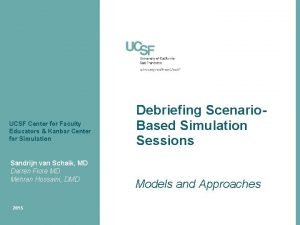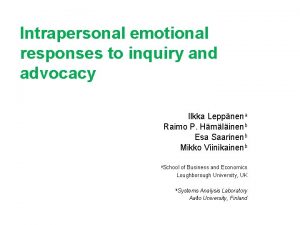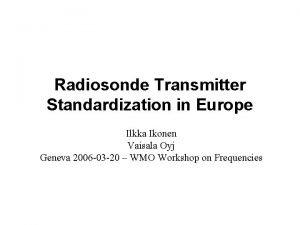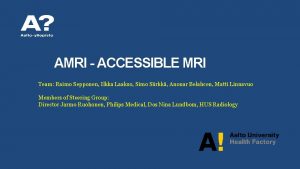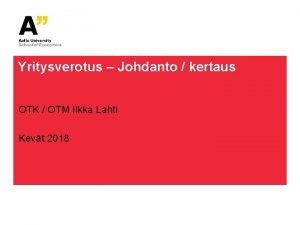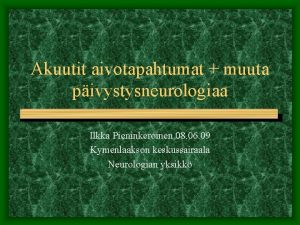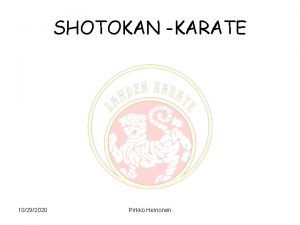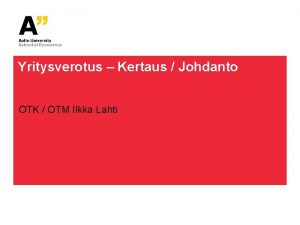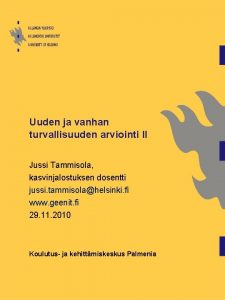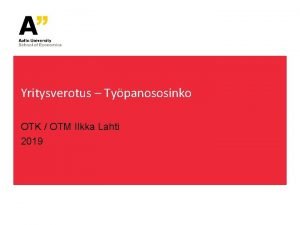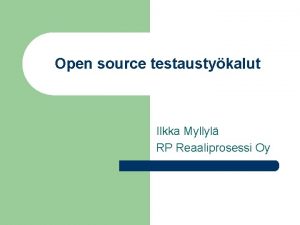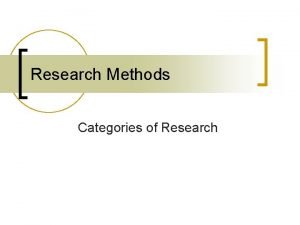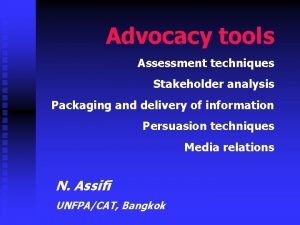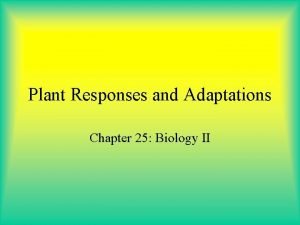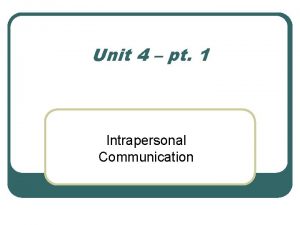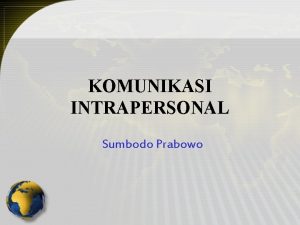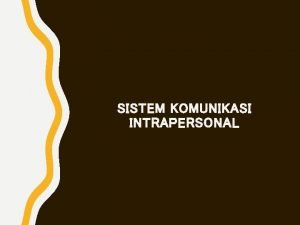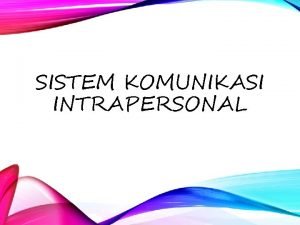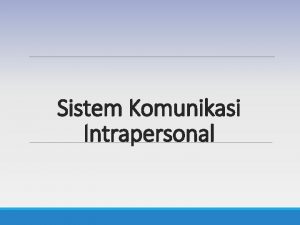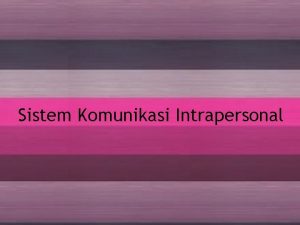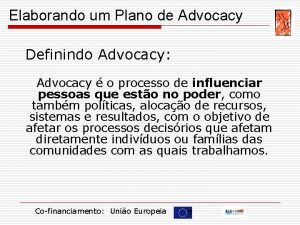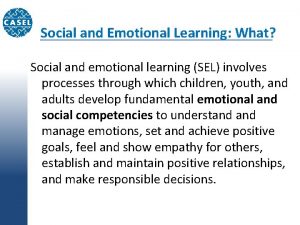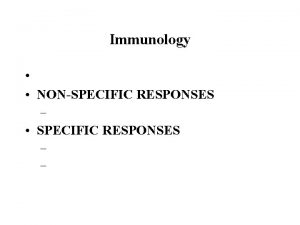Intrapersonal emotional responses to inquiry and advocacy Ilkka





























- Slides: 29

Intrapersonal emotional responses to inquiry and advocacy Ilkka Leppänena Raimo P. Hämäläinenb Esa Saarinenb Mikko Viinikainenb a. School of Business and Economics Loughborough University, UK b. Systems Analysis Laboratory Aalto University, Finland

Emotions play an important role in negotiations • Increasing interest in the GDN community • Emotions also play a role in non face - to - face e-negotiation • Communication behaviour has intrapersonal emotional effects 2015 2

Emotional expressions Positive • Increase co-operation (e. g. Barsade 2002) • Broaden attention and increase cognitive flexibility (e. g. Fredrickson 2001) • Increase trust and willingness to implement the agreement (e. g. Mislin et al 2011) Negative • Anger can elicit larger concessions but also retaliations (e. g. van Kleef at al 2004) 3

Emotions and Negotiations Negotiatior A Negotiatior B Behaviour Cognition Emotional expressions Emotion

Emotions and Negotiations Negotiatior A Cognition Emotion Negotiatior B Communication Behaviour Emotional expressions Cognition Emotion

Communication modes of interest Inquiry • Ask questions, be open, explore and show interest in other’s points of view Advocacy • Assert, be narrow and aggressive, explain own points of view 6

Backgroud • Inquiry improves and is essential in dialoque and organizational learning (Argyris & Schön 1978, Senge 1990, Slotte & Hämäläinen 2015) • Inquiry an approach in Systems intelligence theory (Hämäläinen, Jones & Saarinen 2014, Törmänen, Hämäläinen & Saarinen 2016): positive engagements improve team performance • Balancing inquiry and advocacy can improve decision making by cognitive conflict (Schwenk 1990) 7

Our experiment • Emotional correlates of inquiry and advocacy • Psychophysiological measurements – Emotional expressions: Duchenne smile (genuine positive), non-Duchenne smile (non-genuine), furrowed brows (negative) – Emotional arousal: sympathetic ANS activation • Emotional empathy questionnaire 8

Our hypotheses • Inquiry elicits Duchenne smiles (positive) • Advocacy elicits furrowed brows (negative) • Emotional arousal level is different between inquiry and advocacy • Empathy is related to a high frequency of expressions and a high level of arousal 9

Psychophysiological measurements • Emotional expressions: electromyography (EMG) from 3 muscle regions on the left hemisphere of face • Emotional arousal: skin conductance response (SCR) from left hand fingers 10

Setup Inquiry: take an inquisitive approach on the statements of the persons shown on the screen Advocacy: be critical and if possible, form objections to the statements of the persons shown on the screen • Dimly lit room • Comfortable chair • Stimulus shown on a computer screen Hunting is a great hobby We should abandon nuclear power 11

Stimuli and treatments • In each treatment the subjects are shown photographs with statements. This is the stimuli. Tasks: – – – Inquiry: view the stimuli in an inquiry mode (series of 26 stimuli) Break 1 min Advocacy: view the stimuli in an advocacy mode (series of same 26 stimuli) Break 1 min Neutral: view the stimuli in a neutral mode (series of same 26 stimuli) • Each stimulus shown for 18 s with 5 s breaks in between • Order of stimuli in the series randomized in each treatment • Order of inquiry/advocacy randomized for each subject, neutral treatment always last • Baseline measurement before the treatments, duration 5 min • Total measurement duration 38 min 12

Stimuli and treatments 26 photographs with statements 18 s 5 s 5 s 18 s In randomized order in each treatment baseline (5 min) inquiry (10 min) advocacy (10 min) randomized order neutral (10 min)

EMG electrode placements • A: Corrugator supercilii – contracts the eyebrow A B • B: Orbicularis oculi – wrinkles the eye C • C: Zygomaticus major – raises the cheek 14

• Furrowed brow: only corrugator active in a bin • Duchenne smile: orbicularis and zygomaticus active in a bin • Non-duchenne: only zygomaticus active in a bin 15

EMG score processing • 2048 -Hz signal filtered to 90 -200 Hz, smoothed, logarithmized • Signal during stimulus averaged into 3 s bins • Bin scored active if bin mean > baseline mean • Bin count = sum of active bins 16

SCR score processing • SCR has 2 components: tonic and phasic • Phasic is of interest, corresponds to sudomotor nerve firing at ≈. 62 Hz • 128 -Hz signal down-sampled by half and smoothed, deconvoluted to extract the phasic component, integrated in a 17 s window and logarithmized => ISCR score – Benedek & Kaernbach (2010) – www. Ledalab. de (Matlab add-on) 17

Emotional empathy questionnaire • Mehrabian & Epstein (1972) • Empathy: sharing the emotional experience of others • Before the experiment, 33 item questionnaire – “I makes me sad to see a lonely stranger in a group” – “Some songs make me happy” • => Empathy score 0 – 100 18

Subjects • N = 40, Mage = 34. 6, 22— 61 years • Exclusions from data-analysis: • • 7 excluded because they failed to understand task (post-experiment questionnaire) 6 excluded from SCR analysis because they did not show the signal 19

Duchenne smiles in inquiry • Linear mixed models (LMM) with subjects as random effects • Treatments as deviation coded contrasts • Ref. treatment (neutral) level not shown, moved to zero • Error bars = SEM 20

Non-Duchennes in both inquiry and advocacy • The difference between inquiry and advocacy is not significant (LMM, p =. 79) • => The non-Duchenne smile is not differentially activated in inquiry and advocacy 21

Furrowed brows show reciprocal effect • More furrowed brows in advocacy • Less furrowed brows in inquiry • This is a known pattern of corrugator activation (Larsen et al. 2003) 22

Arousal in both inquiry and advocacy • Arousal is significantly higher in inquiry than in advocacy (LMM, p <. 0001) • Is arousal only related to the smiles? 23

Empathy is related to Duchennes • Subjects with higher empathy scores express more Duchenne smiles (p =. 014) • Others expressions or arousal are not significantly related to empathy 24

Summary of results • First study on the intrapersonal psychophysiological correlates of inquiry and advocacy modes of interaction • Inquiry elicits positive emotions (Duchenne smiles) and advocacy elicits negative emotions (furrowed brows) • Emotional arousal is higher in inquiry than in advocacy and related to positive emotions • More empathetic subjects have more positive emotions 25

Conclusions • Communication mode triggers intrapersonal emotional responses • Essential to realize in negotiations • Inquiry can be used intentionally to generate positive emotional expressions • Unintentional responses can create problems • Psychophysiological measurements and new two person brain imaging methods have potential for GDN research 26

Future research • Psychophysiological correlates of inquiry and advocacy in interactive situations: – Interactive encounters; groups, negotiations – Decision making – Trust and cooperation Role of empathy ? 27

References • Argyris, C. , & Schön, D. A. (1978). Organizational Learning: A Theory of Action Perspective, Addison-Wesley. • Barsade, S. (2002). The ripple effect: Emotional contagion and its influence on group behavior. Administrative Science Quarterly 47, 644– 675. • Benedek, M. , & Kaernbach, C. (2010). A continuous measure of phasic electrodermal activity. Journal of Neuroscience Methods 190, 80 – 91. • Hämäläinen, R. P. , Jones, R. , & Saarinen, E. (2014). Being Better – Living with Systems Intelligence. Aalto University Publications, CROSSOVER 4/2014. • Larsen, J. T. , Norris, C. J. , & Cacioppo, J. T. (2003). Effects of positive and negative affect on electromyographic activity over zygomaticus major and corrugator supercilii. Psychophysiology 40, 776 – 785. • Mehrabian, A. & Epstein, N. (1972). A measure of emotional empathy. Journal of Personality 40, 525 – 543. • Mislin, A. A. , Campagna, R. L. & Bottom, W. P. (2011). After the deal: Talk, trust building and the implementation of negotiated agreements. Organizational Behavior and Human Decision Processes 115, 55 --68. 28

References • Schweiger, D. M. , Sandberg, W. R. , & Rechner, P. L. (1989). Experiential effects of dialectical inquiry, devil’s advocacy, and consensus approaches to strategic decision making. Academy of Management Journal 32, 745 – 772. • Schwenk, C. R. (1990). Effects of devil’s advocacy and dialectical inquiry on decision making: A meta-analysis. Organizational Behavior and Human Decision Processes 47, 161 – 176. • Senge, P. (1990). The Fifth Discipline: The Art & Practice of The Learning Organization, Random House. • Slotte, S. , & Hämäläinen, R. P. (2015). Decision Structuring Dialogue. EURO Journal on Decision Processes 3, 141 -- 159. • Törmänen, J. , Hämäläinen, R. P. , & Saarinen, E. (2016). Systems intelligence inventory. The Learning Organization, 23, 218– 231. • Valacich, J. S. , & Schwenk, C. (1995). Devil’s advocacy and dialectical inquiry effects on face-toface and computer mediated group decision making. Organizational Behavior and Human Decision Processes 63, 158– 173. • Van Kleef, G. A. , De Dreu, C. K. W. , & Manstead, A. S. R. (2004). The interpersonal effects of anger and happiness in negotiations. Journal of Personality and Social Psychology 86, 57– 76. 29
 Kanbar center ucsf
Kanbar center ucsf Advocacy inquiry model
Advocacy inquiry model Ilkka lahti vero
Ilkka lahti vero Ilkka pirskanen koulutus
Ilkka pirskanen koulutus Ilkka ikonen
Ilkka ikonen Ilkka kiviranta
Ilkka kiviranta Laakso ilkka
Laakso ilkka Toiminimi nettovarallisuus
Toiminimi nettovarallisuus Ilkka lahti vero
Ilkka lahti vero Ilkka pirskanen koulutus
Ilkka pirskanen koulutus Eiswein alko
Eiswein alko B-vitamiini alkoholistille
B-vitamiini alkoholistille Pirkko heinonen
Pirkko heinonen Kommandiittiyhtiö verotus esimerkki
Kommandiittiyhtiö verotus esimerkki Jussi tammisola
Jussi tammisola Raportoinnin automatisaatio
Raportoinnin automatisaatio Ilkka lahti otk
Ilkka lahti otk Ilkka lahti otk
Ilkka lahti otk Liikkuva työ ateriakorvaus
Liikkuva työ ateriakorvaus Ilkka koskenniemi
Ilkka koskenniemi Ilkka myllylä
Ilkka myllylä Ilkka mustakallio
Ilkka mustakallio Categories of research design
Categories of research design Advocacy goals and objectives examples
Advocacy goals and objectives examples Advocacy communication and social mobilization
Advocacy communication and social mobilization Monitoring and evaluation in advocacy
Monitoring and evaluation in advocacy Packaging and delivery of information in advocacy
Packaging and delivery of information in advocacy Lsu jonathan sanders
Lsu jonathan sanders Chapter 25 plant responses and adaptations answer key
Chapter 25 plant responses and adaptations answer key Hello goodmorning
Hello goodmorning
